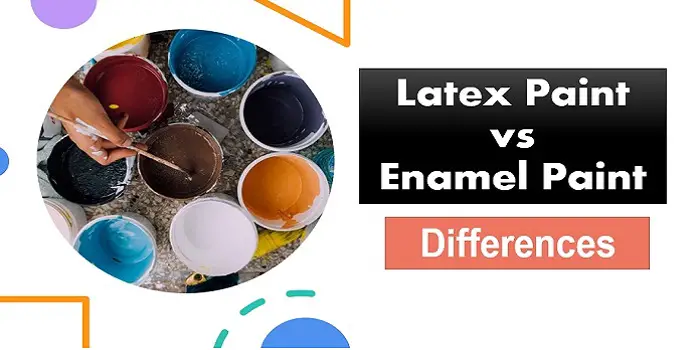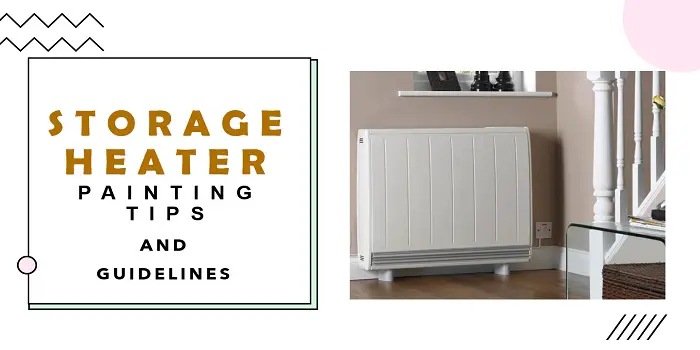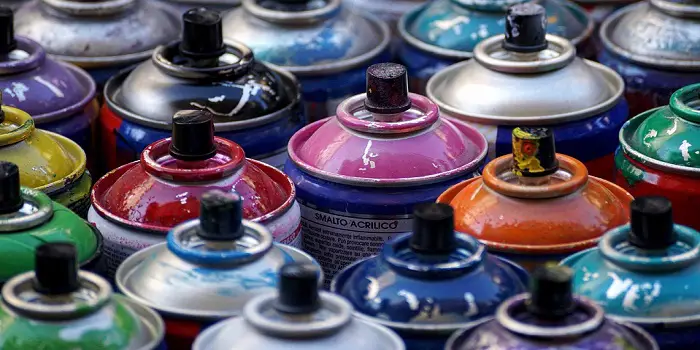
There are many similarities between latex and enamel-based paints.
Being used on interior and exterior surfaces, they come in a wide range of finishes, and they are both relatively easy to apply.
However, if you are trying to decide between the two, then understanding the major difference between latex and enamel will help you make the best-informed decision about which one is the right paint for your needs.
Of course, it helps if you know the differences between all paints on the market which include acrylic and oil-based paints as well.
But here in this article, we will mainly discuss latex and enamel paints.
IMO, the more knowledge you have, the better the decision you will make in this regard.
So, let’s get started…
What's Here in the Article:
Latex vs. Enamel Paint Differences
While enamel and latex paints do have many similarities, the differences between them should be clearly understood before you choose one among them.
Each type of paint has its own characteristics and means of application or removal.
You can see the differences in the characteristics that are listed below.
| Latex (Water-Based) | Enamel (Oil-Based) | |
|---|---|---|
| Odor | Less toxic odor | More toxic odor |
| Finish | Does not last long | High-quality and long-lasting |
| Drying | Dries to touch quickly | Takes a longer time to dry |
| Removal | Easy to remove with water | Not easy to remove, will require thinner |
| Safety | Safer for skin, eyes, and lungs | It can be hazardous to the skin, eyes, and lungs |
Ingredients
The first thing you should note is that neither paint contains latex or enamel despite what it says on the label.
Latex does describe the properties of the paint but is not an ingredient in the paint.
The use of the term latex is shorthand to describe how malleable and flexible the paint is meant to be.
It is why it is often used on areas that tend to expand or contract on the home, such as the expansion joints for example.
Enamel is mostly used for interior paints but again does not contain any enamel.
It is a descriptive term that relates to how the paint will be smooth and durable, just like enamel.
It is really a marketing term that gets you to imagine the paint being glossy, beautiful, and perfect for the interior of your home.
This is important because you may find paint products that claim to be latex and enamel.
Of course, they do not have either in the paint, but again these are descriptive terms used to help you visualize what the paint will do once it is applied to your home.
So, you may see the word “enamel” as part of water-based latex paint to describe how strong and smooth the finish will be.
Water or Oil-Based
It’s not the name but what the paint is based on that makes the real difference between them.
So, a more important difference between enamel and latex paint is that latex paints tend to be water-based while enamel paints tend to be oil-based.
Typically, latex paint is a water-based emulsion where the pigment particles of the paint are suspended in water.
While on the other hand, oil-based paint carries its pigment particles in a thinner mineral spirit or solvent.
This is the most important difference between the two products.
Drying Time
Oil-based enamel paints take longer to dry compared to water-based latex paints.
However, once it has dried, the enamel paint is quite beautiful and will last for a long time.
The downside is that you cannot use water to clean the surface of oil-based paint.
You will need a product that contains paint thinner if you want to remove stains from the surface.
Latex paint dries faster to touch, and you can use water to remove stains from the surface.
It does not last as long as enamel, but it is easier to maintain.
Toxins
Both latex and enamel paints contain toxic materials unless they say otherwise on the label.
However, the real difference between the two types of paints is that oil-based enamel paint contains far more toxins compared to water-based latex paint.
For oil-based enamel paint, the toxic properties are combined with an odor that can be overwhelming if you do not ventilate the area properly.
You may suffer from breathing issues and irritation of the eyes unless you keep the air moving.
While water-based latex paints have less odor and are generally safer, they still contain toxic properties such as volatile organic compounds (VOCs).
This type of pollutant is less dangerous initially but more insidious because it can build up in your home if you do not ventilate properly.
It can especially affect children and seniors, so you should keep them away from the room for any lengthy period.
Plus, keep the fans running until the odor has faded once the paint fully dries.
You should purchase latex paint that has low to no VOCs present.

Enamel vs. Latex: Which Paint to Use and When?
Now that you understand the basic differences, the next step is which paint to use.
This will depend on the results you want to achieve.
Enamel:
This type of paint is used when you need a high-quality product to cover various surfaces such as doors, trim, baseboards, and window frames.
Because these areas of the home are more exposed to the outdoor environment, they need the tough, durable, and beautiful results that only enamel paint can deliver.
Plus, enamel provides a hard surface that can last a long time with minimal maintenance.
Providing a sleek finish that beats acrylic is also a big plus.
Enamel is also used on surfaces such as metal that does not react well to water.
There is an added variety of enamel paints that are known as hybrid enamels.
Although they can be applied in a similar way and provide nearly the same end result (to the oil-borne enamel), they are more eco-friendly because of their low VOC release.
Latex:
Latex is generally better for large surfaces such as walls, given how easy it is to apply.
Plus, any surface that might experience expansion or contraction due to heat or cold is also a candidate for latex paint as enamel may crack under strain.
Such areas include but are not limited to the following.
- Porches
- Deck Flooring
- Drywall Plaster
- Stucco
- Siding
It is true that the distance between alkyd enamel and latex paints has closed in recent years.
This means that latex paints can be used with more confidence when you need a hard, smooth finish that will last for a long time.
It’s still not quite an enamel, but in many cases, it is close.
However, the enamel is still better suited for surfaces that respond well to oil-based paints.
While latex is more versatile, some surfaces such as metal or those exposed to the elements may be better suited for enamel paints.
Be sure to do your research first before deciding which one is right for your needs.
Final Thoughts
You have two kinds of paints, i.e., enamel and latex.
While the former is oil-borne and smooth, the latter uses water-based technology.
Either kind will do for your DIY home remodeling project, provided you know how to use them.
As opposed to what it was before, in recent times, many companies have started producing latex paints that offer much stronger and smoother finishes.
And for this reason, it’s common to see the term “enamel” mentioned on a few of their water-based latex paints.
Keep in mind that there will be some similarities and even crossing of terms, but for the most part, the major difference is the water or oil base for each type of paint.
Share the post "What is the Difference Between Latex Paint and Enamel Paint?"

Douglas Becker (aka Painter Doug) has over twenty years of experience as a painter in Adkins, Texas. At present, he resides in Florida with his family.
From painting multi-storeyed houses, condos, and apartments to large commercial buildings and small offices, he had served various customers in areas not only in Adkins but also in Southwest Florida, Sarasota, Naples, and many more. To know more about him check here.




